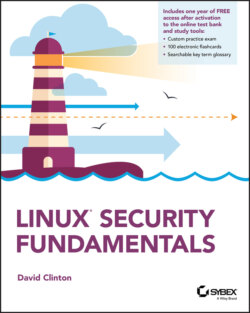Linux Security Fundamentals

Реклама. ООО «ЛитРес», ИНН: 7719571260.
Оглавление
David Higby Clinton. Linux Security Fundamentals
Linux® Security Fundamentals
Acknowledgments
About the Author
About the Technical Editor
CONTENTS
List of Illustrations
Guide
Pages
Introduction
What Does This Book Cover?
Interactive Online Learning Environment and Test Bank
Chapter 1 Using Digital Resources Responsibly
Protecting Personal Rights
Protecting Digital Privacy
What Is Personal Data?
Where Might My Personal Data Be Hanging Out?
Browsing Histories
Ecommerce and Social Media Account Data
Government Databases
Public Archives
The Dark Web
What Are My Responsibilities as a Site Administrator?
Can Escaped Genies Be Forced Back into Their Bottles?
What Can I Do as a User?
Establishing Authenticity
Think About the Source
Be Aware of Common Threat Categories
Summary
Back to the Basics
Review Questions
Chapter 2 What Are Vulnerabilities and Threats?
The Basics: What Are We Trying to Accomplish Here?
What Are Vulnerabilities and Threats?
What Can Be Exploited?
Who’s Doing the Exploiting?
Why Do They Attack?
Identity Theft
Data Exfiltration
Resource Destruction
Common Vulnerabilities
Software Vulnerabilities
Hardware Vulnerabilities
Bioware Vulnerabilities
Digital Espionage
USB Devices
Backdoors
Wireless Entry Points
Stolen Credentials
Data Breaches
Identity Theft (Besides Breaches)
Malware
Network-Based Attacks
Man-in-the-Middle Attacks
Denial-of-Service and Distributed Denial-of-Service Attacks
Network Routing Attacks
Summary
Back to the Basics
Review Questions
Chapter 3 Controlling Access to Your Assets
Controlling Physical Access
Understanding Your Devices
How Compute Works
How Memory Works
How Storage Works
How Peripherals (Might Not) Work
Protecting Your Devices
Who Else Is Watching?
The Problem with USB Devices
Managing Authentication Through Effective Password Use
Password Policies
Password Managers
Multifactor Authentication
Monitoring for Compromised Passwords
Managing Authorization Through Permissions
Controlling Network Access
Firewalls
Software vs. Hardware Firewalls
Local vs. Cloud Firewalls
Virus and Malware Protection
Network Firewalls vs. Application Firewalls
Educating Your Users
Controlling Software Sources
PC Software Repositories
Mobile Package Management
Summary
Back to the Basics
Review Questions
Chapter 4 Controlling Network Connections
Understanding Network Architecture
The Transmission Control Protocol
The Internet Protocol
IPv4 Addressing
NAT Address Translation
IPv6 Addressing
Understanding the Domain Name System
Auditing Networks
Network Auditing Tools
Nmap (Mapping)
Wireshark
Automating Audits
Securing Networks
Patch Your Software
Physically Secure Your Infrastructure
Secure Your Network Behavior
Other Stuff
Summary
Back to the Basics
Review Questions
Chapter 5 Encrypting Your Data at Rest
What Is Encryption?
Encryption Usage Patterns
What Should You Encrypt?
Understanding Hashing vs. Encryption
What Are Blockchains?
Encryption Technologies
Summary
Back to the Basics
Review Questions
Chapter 6 Encrypting Your Moving Data
Website Encryption
Why You Should Use Encryption
How Website Encryption Works
Generating Certificates
Email Encryption
GNU Privacy Guard
Does Gmail Encrypt Your Emails?
Working with VPN Connections and Software Repositories
Securing Your Actions Using VPNs
Securing Transfers from Software Repositories
Summary
Back to the Basics
Review Questions
Chapter 7 Risk Assessment
Conducting Open Source Intelligence Gathering
Accessing Public Vulnerability Databases
Vulnerability Data Frameworks
Vulnerability Data Formats
Vulnerability Data Metrics
Vulnerability Data Management Tools
Conducting Vulnerability Scans
Conducting Penetration Tests
Attack Vectors
Tooling Frameworks
Follow-Up
Summary
Back to the Basics
Review Questions
Chapter 8 Configuring System Backups and Monitoring
Why You Need to Get Backups Right the First Time
Appreciating the Risks
Spreading Your Backups Across Multiple Sites
Testing Your Backups
Meeting Regulatory Compliance
Backup Types
Incremental Backups
Differential Backups
Backup Life Cycles
Multitier Backups
Multisite Storage Solutions
Disaster Recovery Planning
Configuring Monitoring and Alerts
Working with System Logs
Intrusion Detection
Summary
Back to the Basics
Review Questions
Chapter 9 Resource Isolation Design Patterns
Configuring Network Firewalling
Balancing Public and Private Networks
Building Isolated Development Environments
Working with Sandbox Environments
Use Cases for Sandboxes
Sandbox Designs
Controlling Local System Access
Configuring Mandatory Access Controls
Setting Usage Quotas
Summary
Back to the Basics
Review Questions
Appendix Answers to Review Questions. Chapter 1: Using Digital Resources Responsibly
Chapter 2: What are Vulnerabilities and Threats?
Chapter 3: Controlling Access to Your Assets
Chapter 4: Controlling Network Connections
Chapter 5: Encrypting Your Data at Rest
Chapter 6: Encrypting Your Moving Data
Chapter 7: Risk Assessment
Chapter 8: Configuring System Backups and Monitoring
Chapter 9: Resource Isolation Design Patterns
Index. Numbers
A
B
C
D
E
F
G
H
I
J–K
L
M
N
O
P
Q–R
S
T
U
V
W
X–Y–Z
Online Test Bank
Register and Access the Online Test Bank
WILEY END USER LICENSE AGREEMENT
Отрывок из книги
David Clinton
In a previous life, David spent 20 years as a high school teacher. He currently lives in Toronto, Canada with his wife and family and can be reached through his website: https://bootstrap-it.com.
.....
Even getting private references removed from search engine results can involve a long, uphill struggle with no guarantee of success. Thanks to the GDPR, European residents can request help from Google using the Personal Information Removal Request Form. But you can never be sure how that will turn out, and sometimes submitting your request can make things worse. Considering taking down an offending website? Are you sure you even know how to find all the copies? Are you aware, for instance, that the Internet Archive project (https://archive.org/web/), as of this writing, hosts historical versions of more than 376 billion web pages? I’ve actually used the project to recover lost data from 15-year-old iterations of my own sites.
Here’s a good place to start: think carefully before posting anything on an online platform. Are you revealing too much about yourself? Will you be comfortable having your future employers and grandchildren read this 10 or 20 years from now? Try to anticipate the places your content might end up and what value it might have for people you’ve never met—people unconstrained by ethical concerns who care only about making money.
.....